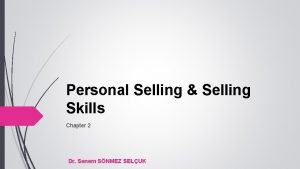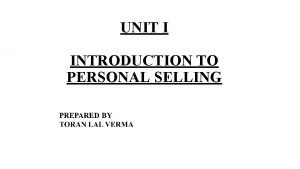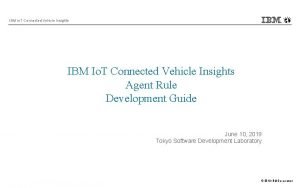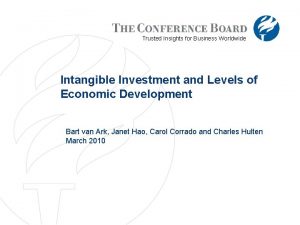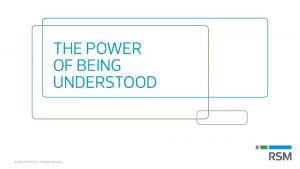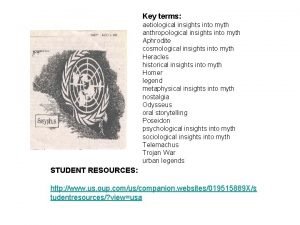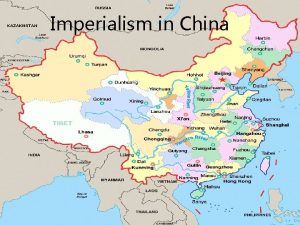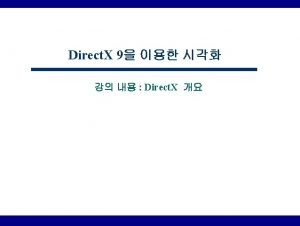Insights into Direct Selling in China June 2010










































- Slides: 42

Insights into Direct Selling in China June 2010

Retailing: Direct Selling in China © Euromonitor International Introduction Chinese Direct Selling in the Global Context Framework of Direct Selling in China Category Performance Competitive Landscape Future Prospects Definitions 2

Introduction Retailing: Direct Selling in China © Euromonitor International Scope • This briefing on the global retailing market covers the following channels, focusing on the year 2009: Non-Store Retailing Global – US$598 billion China – US$10 billion Vending Global – US$60. 5 billion China – US$0. 6 billion Homeshopping Global – US$188. 3 billion China – US$1. 7 billion Disclaimer Much of the information in this briefing is of a statistical nature and, while every attempt has been made to ensure accuracy and reliability, Euromonitor International cannot be held responsible for omissions or errors Figures in tables and analyses are calculated from unrounded data and may not sum. Analyses found in the briefings may not totally reflect the companies’ opinions, reader discretion is advised Internet Retailing Global – US$243. 5 billion China – US$1. 7 billion Direct Selling Global – US$106. 1 billion China – US$6. 1 billion Learn More To find out more about Euromonitor International's complete range of business intelligence on industries, countries and consumers please visit www. euromonitor. com or contact your local Euromonitor International office: London + 44 (0)20 7251 8024 Vilnius +370 5 243 1577 Chicago +1 312 922 1115 Dubai +971 4 372 4363 Singapore +65 6429 0590 Cape Town +27 21 552 0037 Santiago +56 (2) 915 -7200 Shanghai +86 21 63726288 3

Introduction Retailing: Direct Selling in China © Euromonitor International Objectives • The core objective of this report is to examine the current state of the non-store retailing channel, and direct selling in particular, in China in the context of the wider retail market. • In addition to providing a channel overview, the report also analyses performance by product sector, and the state of the competitive landscape, key trends and developments, and prospects and opportunities. • The data and analysis are specific to the Chinese direct selling channel, and where appropriate and relevant it looks at greater detail in beauty and personal care and consumer healthcare. • The direct selling channel is examined in terms of forecast performance over the 2009 -2014 period, with a closer look at 2009 -2010 specifically, identifying key areas of opportunity in terms of product sectors. 4

Introduction Retailing: Direct Selling in China © Euromonitor International Key Findings Direct sales dominate non -store sales in China is the fourth largest direct selling market globally reaching sales over US$6 billion in 2009, with the direct selling channel accounting for the majority of non-store sales in the country. Vitamins and dietary supplements remain the biggest category 56% of all direct sales in China are generated by the growing vitamins and dietary supplement products sector. Amway maintains a clear leading position Amway accounts for 46% of all direct sales in China, and is by far the biggest player. Contributor to growth China was the biggest contributor to growth in Asia-Pacific in 2009, adding US$500 million in sales, and was second only to Brazil globally. Legal framework supports growth Implementation of direct selling legislation has spurred growth since 2005, and created a stable and more secure environment for companies and consumers. Food and drink products are the hottest Food and drink products saw the highest growth rates over the review period, peaking at over 500% in 2006. The high growth has come mainly from meal replacement products like Herbalife Protein Mix. Price premium Products sold by direct sellers are typically mid- to high-end compared with those of store-based retailers. Leading direct selling players, such as Amway, Mary Kay and Herbalife, are all positioned at the mid to premium end of the market. 5

Retailing: Direct Selling in China © Euromonitor International Introduction Chinese Direct Selling in the Global Context Framework of Direct Selling in China Category Performance Competitive Landscape Future Prospects Definitions 6

Chinese Direct Selling in the Global Context Retailing: Direct Selling in China © Euromonitor International Direct Selling In China $6. 1 bn China’s direct selling market is now the fourth largest globally 56. 4% Of all direct sales in China are generated by the growing vitamins and dietary supplement products sector Amway Accounts for 46% of all direct sales in China and is by far the biggest player 7

Chinese Direct Selling in the Global Context Retailing: Direct Selling in China © Euromonitor International China’s Growth Remains Strong • Following the unprecedented contraction in spending during 2009, retail expenditure growth stalled to less than 1% globally. • In contrast, China’s retail sales grew well over the average for Asia-Pacific, and the increase of 8% marked only a slight slowdown on previous years. • The strong growth in non-store sales was even more impressive, as the channel was more dynamic than total retail – grocery and non-grocery retailers alike, growth in sales of which slowed down during 2009, to 6% and 9%, respectively. Retailing Market Snapshot: Total retail sales in 2009 reached US$10. 4 trillion Asia-Pacific retailing market was worth US$2. 7 trillion Chinese market was valued at US$0. 9 trillion 8

Chinese Direct Selling in the Global Context Retailing: Direct Selling in China © Euromonitor International Non-store in Focus • Globally, Internet retailing is the biggest non-store channel and the fastest growing one. • Total Internet retailing sales reached US$244 billion in 2009, up by 5%, despite the less favourable economic conditions. • In China, direct sales are by far the most important non-store channel, with 60% of all non-store sales coming from direct sales. 9

Chinese Direct Selling in the Global Context Retailing: Direct Selling in China © Euromonitor International Direct Sales as Share of Total Retail Sales Direct Sales as Percentage of Total Retail Less than 0. 5% Between 0. 5% and 1% Between 1% and 3% Over 3% 10

Retailing: Direct Selling in China © Euromonitor International Introduction Chinese Direct Selling in the Global Context Framework of Direct Selling in China Category Performance Competitive Landscape Future Prospects Definitions 11

Framework of Direct Selling in China Retailing: Direct Selling in China © Euromonitor International China – Biggest Contributor to Growth in Direct Selling • China is the second biggest retail market in Asia- Pacific and the second fastest growing market, with the highest contribution to overall growth in actual terms. • Direct sales in China rose by US$500 million in 2009, making it the biggest contributor in the region. • Asian countries show great affinity to the direct sales channel, and it is popular both in developed countries like Japan and in developing countries like China. • Direct sales are particularly strong in markets with less developed retail system, as catalogues and agents can reach remote rural locations lacking retail infrastructure easily and cheaply. 12

Framework of Direct Selling in China Retailing: Direct Selling in China © Euromonitor International Legal Framework • China’s direct selling market is highly regulated compared with other countries in the Asia. Pacific region. This is as a result of government regulation on direct selling in late 2005. • The regulations forbid multi-level direct selling, also known as pyramid selling. • Direct selling companies carrying out activities in China are required to apply for a licence from the Ministry of Commerce. • To get a licence, companies need to fulfil at least four important requirements: Direct sales regulations requirements: 1. Registration capital of no less than RMB 80 million. 2. Capital reserves above RMB 20 million. 3. Monthly payment for direct sales personnel, and caps on bonus payments. 4. Special retail outlets in regions where the company has direct selling licence to provide easy access to prices, refunds or other services for consumers and distributors. • In 2005 and 2006, many of the leading direct selling companies sales were negatively impacted by the new regulations. The leading player Amway, for example, saw sales decline sharply between 2005 and 2006. Results of the regulatory changes: • Consolidation within the industry. • Increasing difficult environment for smaller players to operate in. • Single-level marketing is now the most prevalent type of direct selling. 13

Framework of Direct Selling in China Retailing: Direct Selling in China © Euromonitor International Consumer Perceptions Winners Person-to-person Direct selling personnel can provide detailed descriptions and demonstrations of the products they sell, offering tailored service to consumers. Convenience Direct sellers can sell and deliver the products at the homes of their customers, which is convenient for busy consumers. Losers Unprofessional manner Perceived as pushy In China, as many direct selling personnel tend to be less educated, they lack skill in presenting themselves in a professional manner. In underground stations of large cities, such as Shanghai, frequent encounters with direct selling personnel from different companies can lead to impatience among commuters and a negative impression of direct selling as a format, which will have an adverse impact on the company or brand the personnel represent. 14

Framework of Direct Selling in China Retailing: Direct Selling in China © Euromonitor International Direct Sales in 2009 • By July 2009, 24 companies had licences to operate as direct sellers in China. • Between 2008 and 2009, four companies received direct selling licences. • Among the four new players, Harbin Pharmaceutical Group and Jiangsu Longliqi Group Co Ltd are already strong in store-based retailing, and direct selling is intended to be a complementary distribution channel. • Jiangsu Alpay Biotech Co Ltd and Harbin Pharmaceutical Group are mainly engaged in vitamins and dietary supplements direct selling, while Kelti (China) Daily Necessities Co Ltd and Jiangsu Longliqi Group Co Ltd focus on beauty and personal care. 15

Framework of Direct Selling in China Retailing: Direct Selling in China © Euromonitor International Direct sales dynamics over the last five years • Direct sales of home furnishings and housewares saw 40% value growth between 2008 and 2009. • The food and drink sector grew at a 128% CAGR between 2004 and 2009. This rapid growth came mainly from meal replacement products like Herbalife Protein Mix. • Vitamins and dietary supplements was the biggest actual contributor between 2004 and 2009, with an increase of RMB 4. 4 billion. 521% 194% 16

Retailing: Direct Selling in China © Euromonitor International Introduction Chinese Direct Selling in the Global Context Framework of Direct Selling in China Category Performance Competitive Landscape Future Prospects Definitions 17

Category Performance Retailing: Direct Selling in China © Euromonitor International Household Goods Enter the Market • Home furnishings and housewares category saw the strongest growth in direct selling in 2009. • In late 2008, Amway launched high-end cooking utensil products under the Amway Queen brand. • By mid-2009, the industry was describing this launch as success. • The high value sales achieved by this sector is in large part based on high unit prices. Single set of cookware products retail at a price as high as RMB 6, 000. Source: Amway. com. cn 18

Category Performance Retailing: Direct Selling in China © Euromonitor International Limited Product Range in Consumer Appliances • Domestic electrical appliances direct selling • • • underperformed the market in 2009. Vorwerk is the only direct seller offering such products via direct selling in China. The limited product choice has hampered sales. According to industry sources, vacuum cleaners are the only product type available within this category, and many consumers, especially in rural China, perceive vacuum cleaners as a luxury product rather than a necessity. Vacuum cleaners have a low penetration in China, lower than other appliances such as washing machines, fridge freezers and air conditioners. Unit prices for these vacuum cleaners are very high, at around RMB 3, 000 per unit. In the current market context, it is unlikely that there will be any dynamic growth for this sector in direct selling in China in the near future. Cleaning Appliance Series VK 35 Clean Host Daily floor cleaning care, as well As above ground furnishings cleaning dust Household Penetration: China % Households 2009 Consumer Appliances 2009 Fridge Freezers 48. 1 Refrigerators 25. 5 Automatic Washing Machines 56. 3 Dishwashers 3. 0 Upright Vacuum Cleaners 5. 1 Cylinder Vacuum Cleaners 12. 3 Wet and Dry Vacuum Cleaners 7. 8 Handheld Vacuum Cleaners 0. 6 Room Air Conditioners 39. 3 Cleaning Appliance Series EB 351 Deep Cleaning Machine Deep cleaning carpets, mattresses and other fabrics inhibit the propagation of dust mites and reduce allergens. 19

Category Performance Retailing: Direct Selling in China © Euromonitor International Direct Sellers Maintain a Premium • Products sold by direct sellers are typically mid- to high-end compared with store-based retailers. The products of the leading direct selling players, such as Amway, Mary Kay and Herbalife, are all positioned in the middle to premium price range. Premium image Higher quality More sophisticated products Higher price positionin g Sophisticated ingredients or technology Price Comparison Store Brands Direct Sales Brands Yangshengtang: RMB 0. 88 per unit Nutrilite Bio C Plus: RMB 1. 6 per unit Centrum: RMB 1. 1 per unit Nutrilite Chewable Multi: RMB 1. 8 per unit L'Oréal White Perfect: RMB 1, 200 per litre Artistry Pure White Moisturizer: RMB 3, 700 per litre L'Oréal Plénitude Hydrafresh: RMB 2, 200 per litre Mary Kay Time Wise Age-Fighting Moisturizer: RMB 3, 980 per litre 50% Price premium 20

Category Performance Retailing: Direct Selling in China © Euromonitor International VDS Direct Sales Continue to Attracts New Players • In 2009, vitamins and dietary • • • supplements accounted for 56% of direct sales in China. In 2009, direct sales of VDS grew by 9%. This was more than double the overall growth of the sector in China (4%). Amway is the leading player, with 16% of value in 2009, up from 14% in 2008. Healthy growth, as well as lucrative profit margins in direct selling, have already attracted many traditional manufacturers to apply for licences to extend their businesses into this channel. Traditional VDS players are entering direct sales and applying for licences. Between late 2008 and early 2009 Harbin Pharmaceutical Group and Jiangsu Longliqi Group Co Ltd obtained licences to operate via direct selling. The VDS category is relatively new and requires on-site person-to-person explanation of the products’ benefits. The direct selling channel is well placed to meet this need. 21

Category Performance Retailing: Direct Selling in China © Euromonitor International Store Sales Suffered in 2009 • In 2009, as a result of the aggressive expansion of direct selling players, such as Amway, Infinitus and Herbalife, bricks-and-mortar store sales of vitamins and dietary supplements suffered. Direct sales growth – 8. 8% 22

Category Performance Retailing: Direct Selling in China © Euromonitor International Beauty and Personal Care Direct Sales • Beauty and personal • • care is the second largest category within direct sales in China. Direct sales of beauty and personal care amounted to RMB 16 billion in 2009. The international players Amway, Avon and Mary Kay dominate direct sales in the category. Skin care was the most important contributor to category sales in 2009 with a 60% share of value sales. Colour cosmetics, hair care and bath and shower are also important contributors to sales. 23

Category Performance Retailing: Direct Selling in China © Euromonitor International Beauty Products Growth and Shares Further to the right categories with much stronger growth in direct selling: deodorants with 32%, skin care with 21%, and colour cosmetics with 14%. All these products have also a high share of direct sales in China. The bubble for Men’s grooming category is too far on the right to fit onto the chart, due to exceptionally strong growth rate. Men’s toiletries such as men’s skin and hair care a new and exciting territory for personal care industry players. Note: Size of the bubble represents percentage share of direct selling in category sales 24

Retailing: Direct Selling in China © Euromonitor International Introduction Chinese Direct Selling in the Global Context Framework of Direct Selling in China Category Performance Competitive Landscape Future Prospects Definitions 25

Competitive Landscape Retailing: Direct Selling in China © Euromonitor International Corporate strategies in Direct selling Wide product range, multiple categories Product specialist, niche positioning Corporate strategies in direct selling Additional distribution channels Image and brand building vs product and price offer 26

Competitive Landscape Retailing: Direct Selling in China © Euromonitor International Amway – Undisputed Leader • There are similar numbers of multinational and domestic players among the top 10 players in direct sales. Multinational companies, such as Amway, Avon and Mary Kay, have focused more on building up successful brands and growing their direct selling businesses across the country, while domestic players, such as Infinitus and Tianjin Tianshi, have put more efforts into their product portfolios. • New entrants from traditional store-based channels will raise the level of competition in direct selling. Harbin Pharmaceutical Group and Jiangsu Longliqi Group Co Ltd are well-known manufacturing companies in vitamins and dietary supplements and beauty and personal care in China. High brand awareness for the two companies gives their direct selling personnel easier access to their targeted consumers. 27

Competitive Landscape Retailing: Direct Selling in China © Euromonitor International Amway Keeps the Momentum • Amway continued to lead direct sales in 2009, with 46% of value, • • • thanks mainly to its efforts in product innovation, as well as strong support through marketing activities. Its core business includes beauty and personal care, vitamins and dietary supplements and household care products. In 2009, strong double-digit growth was seen within its beauty and personal care product lines, especially for skin care, under the Artistry brand. This was a result of a heavy marketing campaign from the company, as well as frequent product upgrading targeting the most dynamic anti-ageing subsector. Price increases also contributed to the high value growth of the Artistry brand. However, the real star performer of 2009 was the company’s consumer health product brand Nutrilite. Amway held around 10% of the total consumer health market in China in 2009. The Nutrilite brand represented over half of Amway’s total sales in China. Nutrilite is the leading brand in vitamins and dietary supplements, in China with around 13% of value sales. The brand enjoys very high brand awareness in upper tier cities in China, thanks to years of marketing efforts, including TV ads, celebrity endorsement and sponsorship of sports events, such as Nutrilite Health Running. As the leading brand in China’s consumer health market, Nutrilite’s product lines have been stable in recent years. While protein powder is reaching saturation in the market, in 2009, Amway’s focus was on the promotion of its multivitamins Double X, accompanied by ads on TV, in streets and magazines. Amway launched a refill pack for Nutrilite Double X in March 2009. As a result of the good performance of Double X, Amway’s total share increased from 21% in 2008 to 24% in 2009. 28

Competitive Landscape Retailing: Direct Selling in China © Euromonitor International Strategic Direction for Amway in China • As the leading direct sales company in China, Amway (China) Co Ltd will continue to increase its presence at the upper end of the market, with the focus laid on its two flagship brands of Nutrilite and Artistry. • In addition, Amway seeks to diversify its product ranges through investment in new product lines in air purifiers, water purifiers and energy-saving kitchen wares. • The company has experienced dynamic growth in recent years, and it is expected that it will see slightly slower but still health growth over the forecast period, due to its long emphasis on sustainable operations in the Chinese market. 29

Competitive Landscape Retailing: Direct Selling in China © Euromonitor International Infinitus (Lee Kum Lee Co) the Best Performer in 2009 • Tiens Biotech Group Inc, with its Tiens brand, lost • Infinitus (China) Co Ltd enjoyed the biggest share ground in 2009, due to fierce competition from other increase in 2009, of over half a percentage point, to 6%. players, such as Perfect, Amway and Infinitus. • Positioned as a direct selling player solely providing • As an early starter in direct selling, Tiens suffered from traditional Chinese medicine (TCM) ingredients-based maturity in terms of product innovation, marketing format products, Infinitus saw strong growth during the review and distribution channel, which pulled down the overall period, as consumers perceive TCM-based vitamins and performance of the company in 2009. dietary supplements to be healthier. 30

Competitive Landscape Retailing: Direct Selling in China © Euromonitor International Infinitus Strategic Ambitions • Infinitus, as a pioneer in TCM ingredients, has applied a • • • wide range of TCM ingredients, including wolfberry and royal jelly, in Infinitus Nuri-Suit Supplement Meal, benefiting human kidney and liver health. Meanwhile, it also offers products with traditional Chinese magnolia vine, ginseng and tuber of dwarf lily. Infinitus’ brand awareness remains relatively low in China’s wellness product market, particularly in tier I cities, such as Guangzhou. Infinitus is more of a low-profile company which undertakes almost no advertising, unlike Amway, for example. In 2009, the company continued to organise speaking tours by experts to promote the TCM concept among consumers. Infinitus positions itself at the mid-to-higher end of the market. The company premiumised its product lines with the launch of Infinitus Shizhen Capsules in the second half of 2009. The super-premium lingzhi product Infinitus Shizhen Capsules retails at RMB 1, 249 for 90 units, and is targeted at busy, affluent consumers who are seeking wellness products which can help combat ageing and enhance body functionality. Nanfang Lee Kum Kee Co Ltd changed its name to Infinitus (China) Co Ltd in 2009, to be prepared for its next move to develop the global market in 2010. The company has set the ambitious goal of being the number one player in wellness products in the world, taking advantage of its distinctiveness in developing TCM-based products. 31

Competitive Landscape Retailing: Direct Selling in China © Euromonitor International Avon in China • Avon –largest direct seller in the world – is only ranked fourth in direct sales in China is, nevertheless, the fourth largest geographical market for Avon globally with sales reaching RMB 4. 3 billion in 2009. • In China, Avon is present in both store-based retail and non-store retailing formats. In 2009, almost half of its sales in China were generated through retail stores. The company operates 6, 300 retail outlets in China. • In terms of product categories, beauty and personal care products are the focus of Avon in China, with skin care the key product and main growth generator. • Although Avon has had a presence in vitamin and dietary supplements since 2005, it is mainly focused on beautyrelated vitamins and dietary supplements. Despite recent attempts to launch new products, sources indicate that Avon’s VDS sales are not performing well. 32

Competitive Landscape Retailing: Direct Selling in China © Euromonitor International Mary Kay in China • Mary Kay’s sales in China reached RMB 3. 6 billion in 2009. • The Chinese market is one of the most important in the company’s geographic portfolio. The company – ranked fourth in the world – is the second biggest in China. • Skin care is the key product area and growth generator for the company. 33

Competitive Landscape Retailing: Direct Selling in China © Euromonitor International Nu Skin in China • Unlike the previously profiled international direct selling giants Amway, Avon and Mary Kay, Nu Skin’s business in China is relatively small, only recording around RMB 526 million sales in 2009, ranking it in 10 th place. • In China, the company operates mostly in colour cosmetics, skin care and hair care, as well as some vitamins and dietary supplements. • Its vitamins and dietary supplements brand Pharmanex is targeting high-end consumers. For instance, its childspecific VDS products, Pharmanex Jungamals, sell at US$36. 6 for 120 units, higher than Amway’s Nutrilite products. • Due to its relatively high prices, it is unlikely to achieve widespread acceptance for its products among consumers with lower income levels. Approximately 80% of its sales revenues are derived from the tier I and tier II cities, where consumers typically have higher purchasing power. 34

Retailing: Direct Selling in China © Euromonitor International Introduction Chinese Direct Selling in the Global Context Framework of Direct Selling in China Category Performance Competitive Landscape Future Prospects Definitions 35

Future Prospects Retailing: Direct Selling in China © Euromonitor International Direct Sales to Grow Ahead of Retail Overall • Direct sales is predicted to grow at a CAGR of 8% in constant value terms between 2009 and 2014, outperforming overall retail growth. • The rise in unemployment caused by the global economic slowdown will support growth in direct selling. Many of the unemployed are likely to be potential sales personnel for direct selling companies. • The forecast performance is expected to be better than that of the review period, mainly as a result of new entrants, such as Harbin Pharmaceutical Group and Jiangsu Longliqi Group Co Ltd. • Traditional consumer health, beauty and personal care players are expected to extend their established distribution networks, using direct selling as a complementary method to stimulate sales growth. Industry sources suggest that Joincare, a well-known consumer health player, will enter direct selling, after successfully applying for a licence during the forecast period. • Beauty and personal care, as well as consumer health will continue to be the main generators of revenue. • Housewares will be the best performing category in terms of value growth. 36

Future Prospects Retailing: Direct Selling in China © Euromonitor International Home Furnishings and Housewares to Lead Growth • Home furnishings and housewares direct selling will record the strongest growth rate to 2014, albeit from a small and still relatively niche base. Amway’s launch of Amway Queen cooking utensil products is still at an early stage. It is likely to see a rapid growth period, supported by Amway’s strong position and distribution network across the country. • Home care growth is expected to slow down during the forecast period. As daily necessities, home care products such as dishwashing and laundry care widely available within store-based channels, such as hypermarkets/supermarkets, convenience stores and independent grocery retailers, at relatively low prices, while prices of home care products sold through the direct selling channel, such as Amway’s home care products, tend to be higher priced and thus and less affordable to consumers. • Unit prices of direct selling products are unlikely to fall during the forecast period. Indeed, leading direct selling players, such as Amway, plan to increase unit prices further in the future, which will make the price gap between store-based and direct selling channels wider than before. • Benefiting from its TCM expertise and continuous product innovation, Infinitus will continue to see strong growth during the forecast period. In addition to its existing vitamins and dietary supplements, and beauty and personal care product lines, the company is exploring new territories. It has launched a herbal RTD tea product similar to Wong Lo Kat in 2009, indicating its potential expansion into one of the most dynamic soft drinks categories in 37

Retailing: Direct Selling in China © Euromonitor International Introduction Chinese Direct Selling in the Global Context Framework of Direct Selling in China Category Performance Competitive Landscape Future Prospects Definitions 38

Definitions Retailing: Direct Selling in China © Euromonitor International Channel Definitions Retailing • Sales of new and used goods to the general public for personal or household consumption. Excludes specialist retailers of motor vehicles, motorcycles, vehicle parts and fuel. Also excludes foodservice, rental and hire and wholesale industries (cash and carry). Sales value excluding or including VAT/sales tax. Retailing is the aggregation of store-based retailing and non-store retailing. Retailing excludes the informal retail sector. Informal retailing is retail trade which is not declared to the tax authorities. Informal retailing encompasses (a) sales generated by unregistered and unlicensed retailers, ie retailers operating illegally, and (b) any proportion of sales generated by a registered and licensed retailer which is not declared to the tax authorities. Unregistered and unlicensed retailers operate predominantly (although not exclusively) as street hawkers or operate open market stalls, as these channels are harder for the authorities to monitor than permanent outlets. Note, however, that not all street hawkers or open market stalls are informal. The size and importance of informal retailing will depend on many factors that contribute to the general business climate in any given country, such as the extent of government control, regulation and level of corruption. Activities in the “black market”, which is usually understood to refer to trade in illegal, counterfeit or stolen merchandise, are included within the definition of informal retailing. Activities in the “grey market”, which is usually understood to refer to trade in legal merchandise that is sold through unauthorised channels – for example cigarettes bought legally in another country, legally imported, but sold at lower prices than in authorised channels – will be included as informal retailing if no tax is paid on sale by the retailer. However if the retailer pays tax – for example on cigarettes bought legally in another country but sold at a lower price than standard – the sale is included within formal retailing. 39

Definitions Retailing: Direct Selling in China © Euromonitor International Channel Definitions (2) Store-based Retailing • Store-based retailing is the aggregation of grocery retailers and non-grocery retailers. It includes sales of new and used goods to the general public for personal or household consumption from retail outlets or market stalls. It excludes specialist retailers of motor vehicles, motorcycles, vehicle parts and fuel. It also excludes foodservice, rental and hire and wholesale industries, including cash and carry. The informal retail sector is excluded. There are three main data types: sales, outlets, selling space. Sales: retail sales value excluding or including VAT/sales tax. Outlet: a fixed (ie not mobile) business unit that is used principally for retailing, ie selling consumer goods to the general public (see definition of retailing). Each store within a shopping mall is counted separately. Measured at the end of the year. Selling space: floor space within a retail store used for trading. Also known as sales floor area, trade area, trading area, sales area, retail square footage. Includes sales floor, changing rooms, checkouts, areas behind counters, etc. Excludes warehousing, offices, car parks, etc. Measured, as per store count, at the end of the year. Includes self-service warehouse space at Ikea stores and outdoor space in garden centres. Non-Store Retailing • The retail sale of new and used goods to the general public for personal or household consumption from locations other than retail outlets or market stalls. Excludes specialist retailers of motor vehicles, motorcycles, vehicle parts and fuel. Also excludes foodservice, rental and hire, and wholesale industries. For the purposes of this study, nonstore retailing is the aggregation of vending, direct selling, homeshopping and Internet retailing. Vending • Vending means automatic retailing. It covers the sale of products and services at an unattended point of sale through a machine operated by introducing coins, bank notes, payment cards, tokens or other means of cashless payment. Sales figures cover vended products only, ie food, drink and other consumable goods, such as vended tobacco, sanitary products and condoms. Services such as the public telephone, laundrette facilities, travel tickets, stamps, passport photographs, domestic energy supplies and business card creation are excluded. Coverage includes vending systems installed in public and semi-captive environments only. Hotels, transport networks, recreational centres, shopping centres/malls are included. Factories, offices, hospitals, prisons, schools and other captive environments are excluded. 40

Definitions Retailing: Direct Selling in China © Euromonitor International Channel Definitions (3) Homeshopping • Homeshopping is the sale of consumer goods to the general public via mail order catalogues, TV shopping and direct mail. Consumers purchase goods in direct response to an advertisement or promotion through a mail item, printed catalogue, TV shopping programme, or Internet catalogue, whereby the order is placed and payment is made by phone, by post or through other media, such as digital TV. It excludes sales on returned products/unpaid invoices. Internet retailing is also excluded. Example brands include Otto, Neckermann, QVC. Internet Retailing • Sales of consumer goods to the general public via the Internet. Consumers purchase goods online through the web platform. Sales data are attributed to the country where the consumer is based, rather than where the retailer is based. Also includes orders placed through the web for which payment is then made through a store card, an online credit account subsequent to delivery or on delivery of the product. This payment may be by any mode, including postal cheque, direct debit, standing order or other banking tools. Includes mobile retailing (m-commerce), whereby consumers use wireless devices, such as mobile phone, PDA, Black. Berry, to connect to the Internet and purchase the goods online. Excludes sales of wallpapers and ringtones. Includes digital music and movie downloads. Example brands include Amazon. com, Zappos. com, Apple. com, Tesco. com, Dell. com, Coles Online, Quelle and Americanas. Internet retailing excludes sales of: (a) Products generated over consumer-to-consumer sales sites, such as e. Bay. All sales over such sites are excluded, even if they were generated by companies operating through the site; (b) Sales of motor vehicles, motorcycles and vehicle parts; (c) Tickets for events (sports, music concerts, etc) and travel; (d) Sales of holidays; (e) Revenue generated by online gambling sites; (f) Quick delivery services of food, magazines, household goods and DVD rentals, for example: Max. Delivery. com, Lickety. Ship. com, Netflix. com, Love. Film (g) Returned products/unpaid invoices. Direct Selling • Direct selling is the marketing of consumer goods directly to consumers, generally in their homes or the homes of others, at their workplace and other places away from permanent retail locations. Direct selling occurs in two primary ways: one-to-one basis (usually by prior arrangement, a demonstration is given by a direct seller to a customer) or party-plan basis (selling through explanation and demonstration of products to a group of prospective customers by a direct seller, usually in the home of a host or hostess who invites other persons for this purpose). The prime example of the one-to-one method is Avon. Tupperware is famous for its party-plan method. For the purposes of this study, direct selling of services – such as insurance, telecoms, other utilities and financial services – are excluded. 41

Retailing: Direct Selling in China © Euromonitor International Experience more. . . This research from Euromonitor International is part of a global strategic intelligence system which offers a complete picture of the commercial environment. Also available from Euromonitor International: Global Briefings Global Company Profiles Country Market Insight Reports The state of the market globally and regionally, emerging trends and pressing industry issues: timely, relevant insight published every month. The competitive positioning and strategic direction of the leading companies including uniquely sector-specific sales and share data. The key drivers influencing the industry in each country; comprehensive coverage of supply-side and demand trends and how they shape the future outlook. Interactive Statistical Database Strategy Briefings Learn More Market sizes, market shares, distribution channels and forecasts; the complete market analysed at levels of category detail beyond any other source. Executive debate on the global trends changing the consumer markets of the future. To find out more about Euromonitor International's complete range of business intelligence on industries, countries and consumers please visit www. euromonitor. com or contact your local Euromonitor International office: London + 44 (0)20 7251 8024 Chicago +1 312 922 1115 Singapore +65 6429 0590 Shanghai +86 21 63726288 Vilnius +370 5 243 1577 Dubai +971 4 372 4363 Santiago +56 2 9157200 42
 Trade selling and missionary selling
Trade selling and missionary selling Inside order taker
Inside order taker June 2007 physics regents
June 2007 physics regents Danswer
Danswer Introduction to personal selling
Introduction to personal selling Direct marketing and personal selling
Direct marketing and personal selling Personal selling vs direct marketing
Personal selling vs direct marketing Scope of direct selling
Scope of direct selling Direct selling vs traditional marketing
Direct selling vs traditional marketing Data analytics quotes
Data analytics quotes Karapalo
Karapalo Social media consumer insights
Social media consumer insights Relie responsible lending and insights engine
Relie responsible lending and insights engine Ibm maximo asset health insights
Ibm maximo asset health insights Marketing approach to demand measurement
Marketing approach to demand measurement Managing marketing information
Managing marketing information Aruba ai insights
Aruba ai insights Ibm connected vehicle insights
Ibm connected vehicle insights Exploration insights portfolio
Exploration insights portfolio Code of ethics for teachers article 3
Code of ethics for teachers article 3 Presenting insights and findings using written reports
Presenting insights and findings using written reports Cisco nia future releases
Cisco nia future releases Family office insights
Family office insights Insights to behavior
Insights to behavior Insights dundee
Insights dundee Connected vehicle insights
Connected vehicle insights Insights on demand gpc
Insights on demand gpc Insights and understanding ecclesiology
Insights and understanding ecclesiology Martini tag insights
Martini tag insights Residential customer insights
Residential customer insights Key insights
Key insights Trusted insights
Trusted insights Using marketing information to gain customer insights
Using marketing information to gain customer insights Sustainability npd insights
Sustainability npd insights Awm insights
Awm insights Elicit insights
Elicit insights Dynatrace azure
Dynatrace azure Course insights purdue
Course insights purdue Digital adoption platform walkme
Digital adoption platform walkme Behavioural insights team
Behavioural insights team Customer insights
Customer insights Translink insights
Translink insights Gov.uk verify barclays
Gov.uk verify barclays
